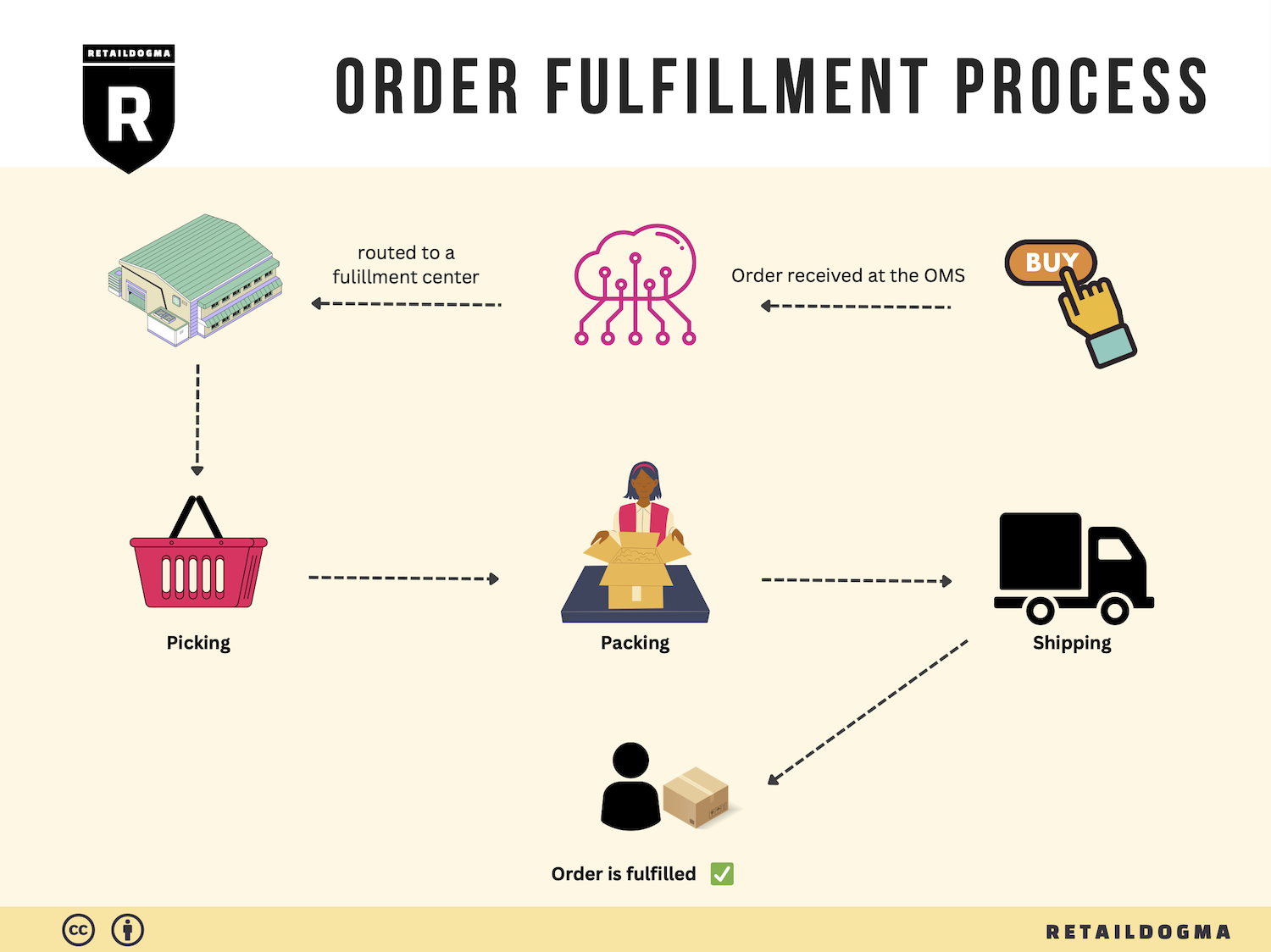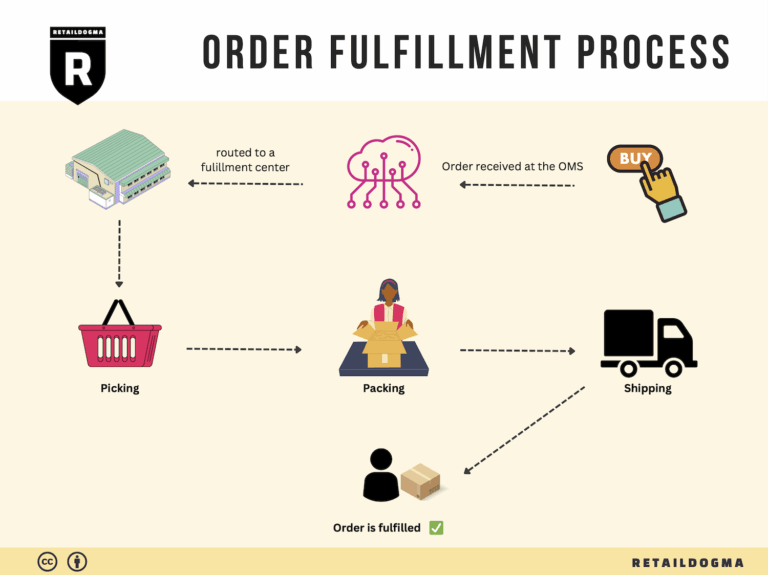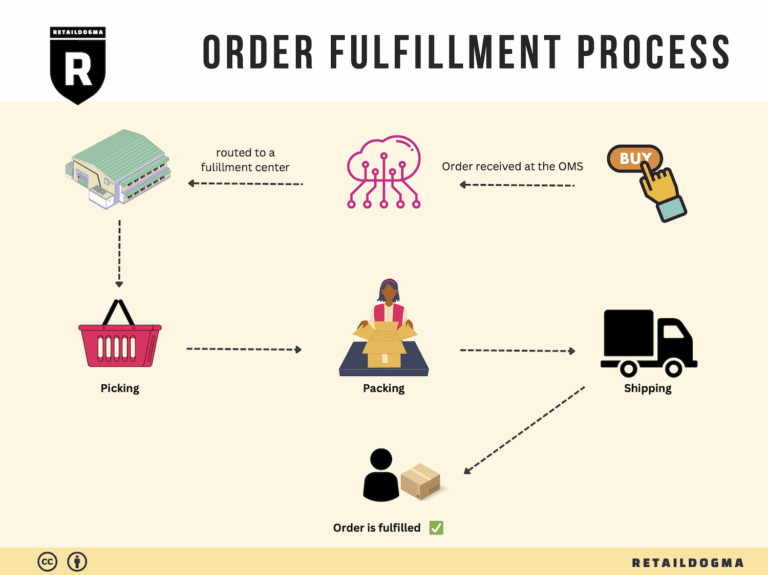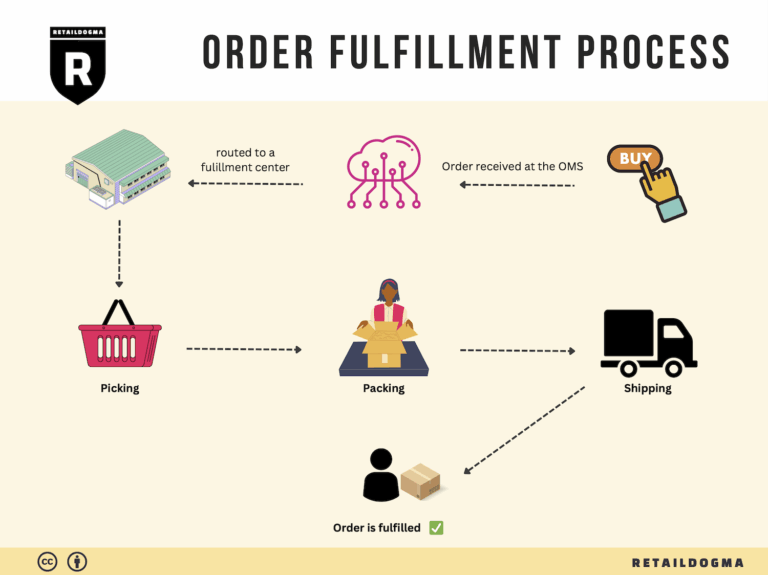How Order Fulfillment Works: A Step-by-Step Guide for Businesses
What is E-commerce Fulfillment? An Introduction for Growing Businesses
Understanding E-commerce Fulfillment: A Path to Streamlined Operations
As your e-commerce business begins to grow, the excitement of increased sales can quickly turn into a daunting challenge—especially when it comes to packing and shipping orders. Many business owners find themselves overwhelmed by the logistics of fulfillment, which can detract from their ability to focus on scaling their operations and enhancing customer experiences. This is where understanding e-commerce fulfillment becomes crucial.
At its core, fulfillment is the process of getting a product from your inventory to your customer’s doorstep. It encompasses everything from receiving inventory and storing products to picking, packing, and shipping orders. When executed efficiently, a solid fulfillment strategy can significantly enhance your business’s operational efficiency and customer satisfaction.
In this guide, we will explore the different models of e-commerce fulfillment that can help you navigate this complex landscape. We’ll delve into the advantages of using Third-Party Logistics (3PL) providers and Amazon’s Fulfillment by Amazon (FBA) service, both of which can alleviate the burden of handling logistics on your own. Understanding these options will empower you to choose the best strategy that aligns with your business goals.
We will also cover the core services involved in fulfillment, including inventory management, order processing, shipping, and returns handling. Each of these components plays a vital role in ensuring that your customers receive their orders promptly and accurately, which is crucial for maintaining trust and loyalty.
Choosing the right fulfillment partner is another critical aspect we’ll address. We’ll provide insights on what to consider when evaluating potential partners, such as their technology capabilities, geographical reach, and service reliability. These factors can significantly impact your overall efficiency and customer satisfaction.
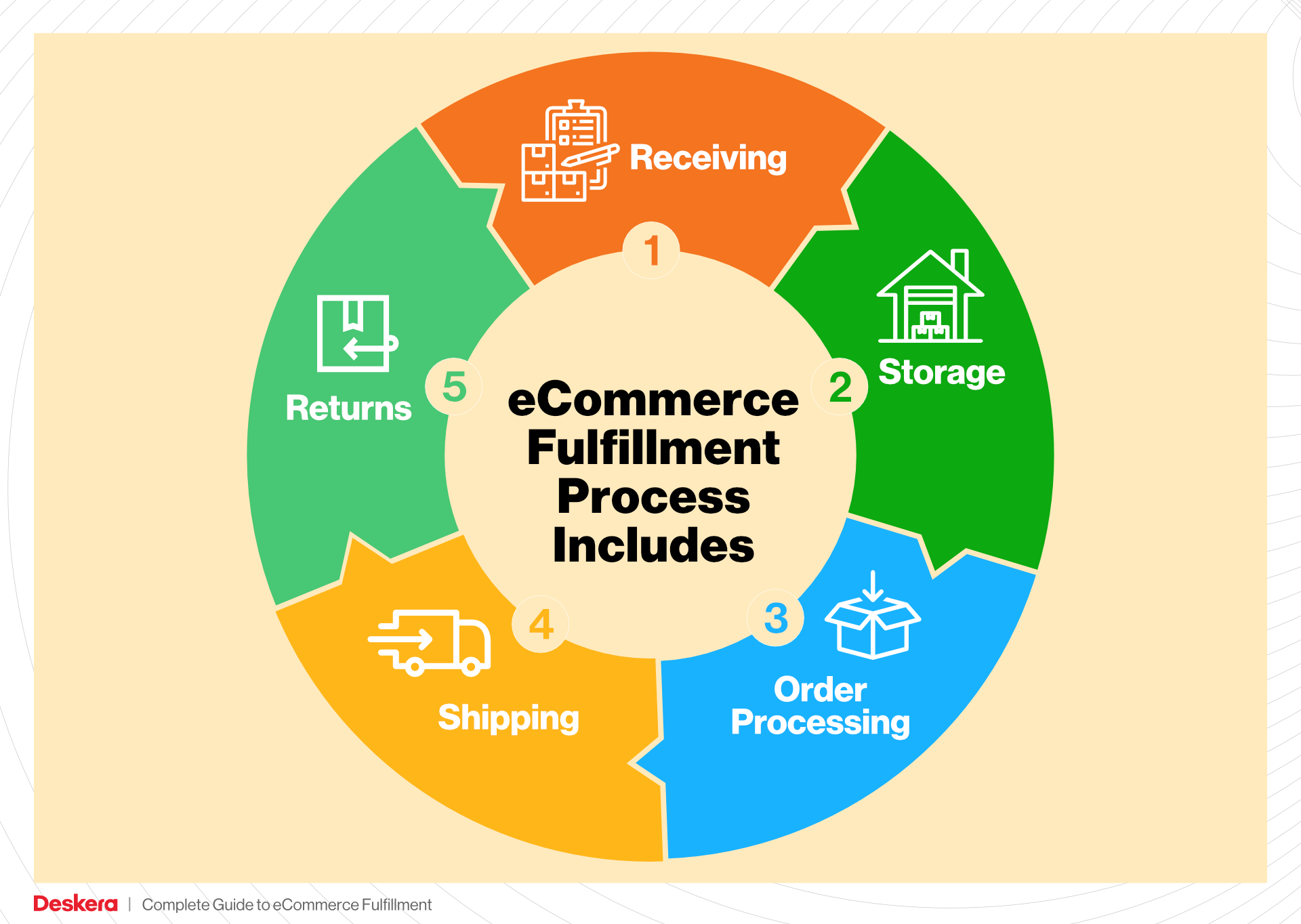
Finally, we’ll touch upon pricing structures associated with different fulfillment models, helping you understand the cost implications of each option.
The goal of this guide is to empower you, as a business owner, to make informed decisions about your logistics strategy. By mastering the intricacies of e-commerce fulfillment, you can streamline your operations, reduce costs, and ultimately enhance your customer experience—setting the stage for sustainable growth in your business.
What You’ll Learn In This Guide
- What is E-commerce Fulfillment? An Introduction for Growing Businesses
- The Order Fulfillment Process: From ‘Buy’ Button to Customer’s Door
- Comparing Fulfillment Models: In-House vs. 3PL vs. Dropshipping
- A Deep Dive into Amazon FBA: Pros, Cons, and Who It’s For
- Core Services Offered by Fulfillment Centers
- How to Choose a Fulfillment Partner: A 6-Point Checklist
- Understanding Fulfillment Pricing: A Breakdown of Common Fees
- Frequently Asked Questions (FAQs) about Fulfillment
- Conclusion: Is Outsourcing Fulfillment the Right Move for Your Business?
- Important Disclaimer
The Order Fulfillment Process: From ‘Buy’ Button to Customer’s Door
1. Receiving Inventory
The order fulfillment process begins with receiving inventory at the fulfillment center, such as Amazon’s LBE1 warehouse. This step is critical as it establishes the foundation for the entire supply chain. When products arrive, they are unloaded, inspected for quality, and verified against purchase orders to ensure accuracy.
Key terms associated with this step include SKU (Stock Keeping Unit), which is a unique identifier for each product. Properly managing SKUs is vital for inventory control, enabling businesses to track stock levels, manage reorders, and reduce stockouts. Effective receiving processes also help mitigate discrepancies that could lead to fulfillment delays, ultimately enhancing customer satisfaction.
2. Warehouse Storage
After the inventory has been received and verified, it is then organized and stored within the fulfillment center. This step involves categorizing products based on various criteria such as size, type, and demand. Efficient warehouse storage maximizes space utilization and ensures quick access to items when orders are placed.
A key term here is bin location, which refers to the specific areas within the warehouse where products are stored. Implementing a systematic bin location strategy can significantly streamline the picking process later on. Effective storage not only supports efficient order fulfillment but also reduces the time spent searching for products, thus increasing overall operational efficiency.
3. Order Picking
Once a customer places an order, the next step is order picking, where items are retrieved from their designated storage locations. This step is crucial as it directly impacts order accuracy and fulfillment speed. Workers use tools such as pick lists, which detail the items and quantities needed for each order, to efficiently gather products.
There are various picking methods, including single order picking and batch picking, each suited for different types of orders. For instance, batch picking allows workers to collect multiple orders simultaneously, optimizing time and resources. The accuracy of this step is vital; errors in picking can lead to incorrect shipments, resulting in returns and dissatisfied customers.
4. Order Packing
After items have been picked, they move to the packing station, where they are prepared for shipment. During this step, products are carefully packed into boxes, and shipping labels are generated. Proper packing is essential to protect items during transit and minimize damage.
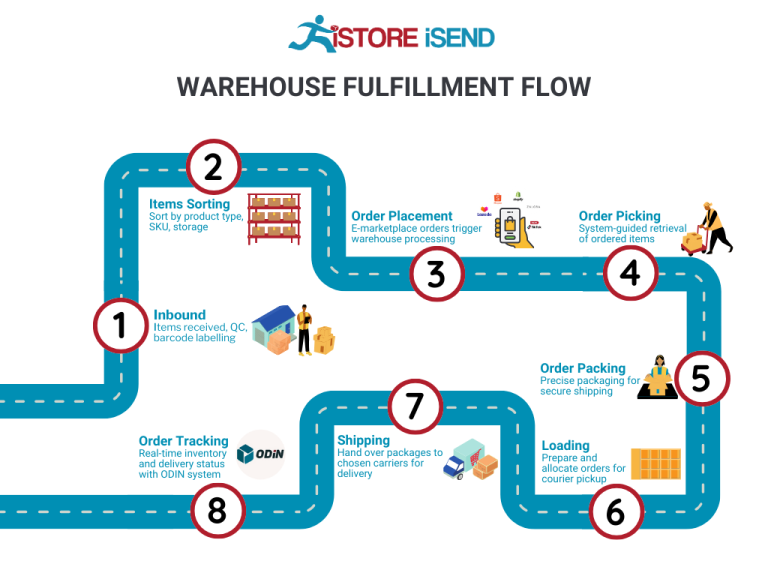
A key term associated with this phase is packing slips, which accompany the order and provide details about the contents. These slips are important for both the fulfillment team and the customer, as they serve as a confirmation of what has been shipped. Efficient packing processes can also help reduce shipping costs, as optimizing box sizes and materials can lead to lower dimensional weight charges from carriers.
5. Shipping & Delivery
The final step in the order fulfillment process is shipping and delivery. Once packages are packed, they are handed over to shipping carriers for delivery to the customer’s address. This step is critical as it directly affects delivery speed and customer satisfaction.
Key terms in this phase include last-mile delivery, which refers to the final leg of the shipping journey from a distribution center to the end customer. Efficient last-mile delivery is vital for meeting customer expectations for fast shipping. Businesses often utilize advanced tracking systems to provide real-time updates to customers about their order status, enhancing transparency and trust.
In conclusion, mastering the order fulfillment process is essential for e-commerce businesses aiming to scale effectively. Each step—from receiving inventory to shipping and delivery—plays a crucial role in ensuring a seamless customer experience. By implementing best practices and utilizing key terminologies, businesses can optimize their fulfillment processes, reduce costs, and improve customer satisfaction.
Comparing Fulfillment Models: In-House vs. 3PL vs. Dropshipping
Fulfillment Model Comparison
| Model | Who Handles Inventory | Best For (Business Stage) | Key Advantage | Key Disadvantage |
|---|---|---|---|---|
| In-House Fulfillment | The business itself | Established businesses | Greater control over inventory and operations | High fixed costs and scalability challenges |
| Third-Party Logistics (3PL) | An external logistics provider | Growing businesses | Flexibility and scalability | Potential loss of control over operations |
| Dropshipping | Supplier or manufacturer | Startups and small businesses | Low overhead and minimal risk | Lower profit margins and reliance on suppliers |
In-House Fulfillment
In-house fulfillment involves a business managing its own inventory and warehousing. This model is best suited for established businesses that have reached a level of sales where they can invest in their own logistics. The key advantage of in-house fulfillment is the greater control it offers over inventory management, order processing, and shipping. Businesses can tailor their operations to fit their specific needs, ensuring that they maintain brand consistency and quality control throughout the fulfillment process. However, this model comes with significant disadvantages, including high fixed costs associated with maintaining a warehouse, hiring staff, and investing in technology. Additionally, as demand fluctuates, businesses may struggle to scale operations efficiently, leading to potential overstock or stockouts.
Third-Party Logistics (3PL)
Third-party logistics (3PL) providers offer a solution for businesses looking to outsource their fulfillment operations. This model is particularly beneficial for growing businesses that require flexibility and scalability in their logistics. By partnering with a 3PL, companies can leverage the provider’s expertise, technology, and infrastructure to manage warehousing, inventory, and shipping. The key advantage of using a 3PL is the ability to scale quickly without the burden of significant upfront investments in logistics infrastructure. However, a key disadvantage is the potential loss of control over the fulfillment process. Businesses may find it challenging to ensure that their brand standards are met when relying on an external provider, leading to issues with customer satisfaction if the service does not align with their expectations.
Dropshipping
Dropshipping is a fulfillment model where the retailer does not keep goods in stock but instead transfers customer orders and shipment details to a supplier or manufacturer, who then ships the products directly to the customer. This model is ideal for startups and small businesses looking to minimize overhead costs and financial risk. The primary advantage of dropshipping is the low barrier to entry, allowing entrepreneurs to start selling without significant upfront investment in inventory or warehousing. However, the model has its drawbacks, particularly concerning profit margins and reliance on suppliers. Retailers often face lower profit margins due to the fees associated with dropshipping and may experience delays or issues with product quality if the supplier does not meet their standards. This reliance can lead to challenges in maintaining customer satisfaction and brand loyalty.
Conclusion
Choosing the right fulfillment model is crucial for e-commerce businesses, as it directly impacts operational efficiency, customer satisfaction, and ultimately, profitability. In-house fulfillment provides control but at a higher cost and complexity, while 3PL offers flexibility and scalability but may sacrifice some control. Dropshipping is appealing for its low risk and overhead but comes with challenges related to profit margins and supplier reliability. Understanding these models and their implications is essential for business owners and operations managers as they scale their sales and logistics.
A Deep Dive into Amazon FBA: Pros, Cons, and Who It’s For
Understanding Fulfillment by Amazon (FBA)
Fulfillment by Amazon (FBA) is a logistics service offered by Amazon that allows sellers to store their products in Amazon’s fulfillment centers. Amazon takes care of storage, packaging, and shipping, as well as handling customer service and returns. Sellers can utilize this service to streamline their operations and leverage Amazon’s extensive logistics network.
When a customer places an order for a product fulfilled by FBA, Amazon picks, packs, and ships the product directly to the customer. This process is designed to enhance efficiency and provide a seamless shopping experience for buyers. Sellers benefit from Amazon’s trusted reputation and vast customer base, which can significantly increase their sales potential.
How FBA Works
-
Setting Up an FBA Account: To start using FBA, sellers need to create an Amazon seller account and enroll in the FBA program. They can then set their products as FBA-eligible.
-
Shipping Inventory to Amazon: Sellers prepare their products according to Amazon’s guidelines and ship them to designated fulfillment centers. The FBA warehouse code (such as LBE1 in New Stanton, PA) indicates the specific location where products will be stored.
-
Storage and Management: Once the inventory arrives at the fulfillment center, Amazon takes responsibility for storage. Sellers can monitor their inventory levels through the Seller Central dashboard.
-
Order Fulfillment: When a customer orders a product, Amazon handles the entire fulfillment process, from picking the item off the shelf to packing and shipping it. Customers receive notifications, tracking information, and can benefit from Prime shipping.
-
Customer Service and Returns: Amazon manages all customer service inquiries and returns for FBA products, allowing sellers to focus on other aspects of their business.
Pros of FBA
-
Prime Eligibility: Products fulfilled through FBA are eligible for Amazon Prime, which attracts a significant number of loyal customers looking for quick and free shipping options. This can lead to higher conversion rates.
-
Customer Trust: Selling through FBA enhances trust with customers. Amazon’s brand reputation for reliable service reassures buyers, often resulting in higher sales volumes.
-
Multi-Channel Fulfillment: FBA isn’t limited to Amazon sales. Sellers can use FBA to fulfill orders from other sales channels, such as their own websites, eBay, or Shopify, providing flexibility in operations.
-
Scalability: With Amazon handling logistics, sellers can scale their businesses without needing to invest in their own warehousing and shipping infrastructure.
-
Time-Saving: FBA simplifies logistics, allowing sellers to focus on marketing, product development, and customer engagement rather than fulfillment tasks.
Cons of FBA
-
High Fees: FBA comes with various fees, including storage fees for inventory and fulfillment fees for each order processed. These can accumulate, especially for sellers with low-margin products.
-
Strict Inventory Rules: Amazon has specific inventory management rules, including requirements for labeling and packaging. Sellers must adhere to these guidelines to avoid penalties or removal of their inventory.
-
Commingling Risks: FBA uses a process called commingling, where inventory from multiple sellers may be stored together. This can lead to issues if products are damaged or if there are discrepancies in returns, as sellers may receive returns for products they didn’t ship.
-
Limited Control: Once inventory is at Amazon’s fulfillment center, sellers have limited control over their products. Any issues related to inventory management or customer service are handled by Amazon, which can lead to potential conflicts.
-
Long-Term Storage Fees: If inventory remains unsold for an extended period, sellers may incur long-term storage fees, impacting profitability.
Who is FBA Best For?
Fulfillment by Amazon is ideal for a variety of sellers, particularly those looking to scale their operations without the burden of managing logistics. Here are some categories of sellers who may benefit most from FBA:
-
Small to Medium-Sized Businesses: Businesses that lack the infrastructure for warehousing and shipping can leverage FBA to access Amazon’s robust logistics network.
-
New Entrepreneurs: Individuals just starting their e-commerce journey can use FBA to minimize upfront investments in logistics, allowing them to focus on product sourcing and marketing.
-
Brands Seeking Visibility: Established brands looking to enhance their visibility and sales on Amazon can take advantage of FBA’s Prime eligibility and customer trust.
-
Multi-Channel Sellers: Businesses that sell across multiple platforms can streamline their operations by using FBA for fulfillment across all channels.
-
Seasonal Sellers: Sellers with seasonal products can benefit from FBA by utilizing Amazon’s logistics during peak seasons without needing to maintain a permanent inventory solution.
In conclusion, while FBA offers numerous advantages, including increased sales potential and reduced logistical burdens, it is crucial for sellers to weigh these benefits against the associated costs and risks. By understanding both the pros and cons, e-commerce business owners can make informed decisions about whether FBA aligns with their operational goals and business model.
Core Services Offered by Fulfillment Centers
Inventory Management & Warehousing
Inventory management and warehousing are foundational services provided by fulfillment centers. This process involves the systematic tracking of inventory levels, orders, sales, and deliveries. Fulfillment centers utilize advanced software systems to monitor inventory in real-time, ensuring that e-commerce businesses have accurate insights into their stock levels.
Benefits:
1. Reduced Stockouts and Overstocks: By maintaining optimal inventory levels, businesses can avoid stockouts that lead to lost sales and overstocks that tie up capital.
2. Improved Cash Flow: Efficient inventory management allows for better cash flow management, enabling businesses to invest in growth opportunities.
3. Space Optimization: Fulfillment centers provide the necessary warehousing space, allowing businesses to focus on sales and marketing instead of managing physical inventory logistics.
4. Scalability: As businesses grow, fulfillment centers can easily scale their warehousing solutions to accommodate increased inventory without the need for significant capital investment in real estate.
Pick and Pack Services
Pick and pack services refer to the process of selecting products from inventory (picking) and preparing them for shipment (packing). Fulfillment centers employ specialized staff and technology to streamline this process, ensuring that orders are accurately filled and shipped in a timely manner.
Benefits:
1. Accuracy and Speed: With trained personnel and automated systems, fulfillment centers can significantly reduce picking errors and expedite the packing process, leading to faster order fulfillment.
2. Cost Efficiency: Outsourcing pick and pack services can lower operational costs compared to managing this process in-house, as fulfillment centers leverage economies of scale.
3. Enhanced Customer Satisfaction: Quick and accurate order fulfillment leads to improved customer satisfaction and loyalty, essential for e-commerce success.
4. Flexibility in Order Sizes: Whether dealing with bulk orders or single-item purchases, fulfillment centers can efficiently handle various order sizes without compromising service quality.
Kitting and Assembly
Kitting and assembly involve combining multiple products into a single package or preparing items for sale. This service is particularly beneficial for e-commerce businesses that offer bundled products or require assembly before shipping.
Benefits:
1. Streamlined Operations: By allowing fulfillment centers to handle kitting and assembly, businesses can streamline their operations and focus on core activities like marketing and product development.
2. Customization Options: Businesses can offer customized kits or bundles to their customers, enhancing the shopping experience and potentially increasing average order values.
3. Reduced Time to Market: With efficient kitting and assembly processes, businesses can quickly respond to market demands, launching new products or bundles faster than competitors.
4. Inventory Management: Fulfillment centers can manage the inventory of individual components and finished kits, ensuring that businesses maintain optimal stock levels for both.
Returns Management (Reverse Logistics)
Returns management, or reverse logistics, is the process of handling returned products. Fulfillment centers provide essential services for processing returns, including inspection, restocking, and managing exchanges or refunds.
Benefits:
1. Enhanced Customer Experience: Efficient returns management is crucial for customer satisfaction. Fulfillment centers can streamline the process, making it easy for customers to return products, which can enhance brand loyalty.
2. Cost Recovery: By effectively managing returns, businesses can recover costs associated with returned products through resale or refurbishment, minimizing financial losses.
3. Data Insights: Fulfillment centers can provide valuable data on return reasons, allowing businesses to identify product issues and improve future offerings.
4. Operational Efficiency: Outsourcing returns management allows businesses to allocate resources more effectively, focusing on growth rather than the complexities of handling returns in-house.
In summary, fulfillment centers offer a suite of core services that can significantly enhance the efficiency and effectiveness of e-commerce operations. By leveraging these services, businesses can streamline their logistics, improve customer satisfaction, and ultimately drive growth.
How to Choose a Fulfillment Partner: A 6-Point Checklist
Location & Warehouse Network
Choosing a fulfillment partner with the right location and warehouse network is crucial for optimizing shipping times and costs. The closer the fulfillment center is to your customer base, the faster and cheaper the shipping will be.
Key Questions:
– Where are the partner’s warehouses located, and how many do they operate?
– Do they have warehouses in key regions that align with your target market?
– What is their shipping range, and how do they manage logistics for remote areas?
A well-distributed network allows for efficient distribution and can significantly enhance customer satisfaction through quicker delivery times.
Technology & Integrations
In today’s e-commerce landscape, technology is the backbone of operations. A proficient fulfillment partner should offer robust systems that integrate seamlessly with your e-commerce platform, inventory management, and other tools.
Key Questions:
– What fulfillment management software do they use, and is it compatible with your existing systems?
– Do they offer real-time tracking and reporting capabilities?
– How do they handle inventory management, and can you access data at any time?
Investing in a partner with advanced technology can lead to improved accuracy in order fulfillment and inventory management, ultimately saving time and reducing errors.
Specializations (e.g., Cold Storage, Oversized Items)
Different businesses have unique needs, and not all fulfillment partners can handle specialized requirements. If your products require specific handling (like cold storage for perishables or special care for oversized items), finding a partner with the right expertise is essential.
Key Questions:
– What specializations does the fulfillment partner offer?
– Do they have the necessary facilities and equipment for your specific product types?
– Can they manage compliance with industry standards related to your products?
Understanding their capabilities in handling specialized items ensures that your products are stored and shipped correctly, minimizing the risk of spoilage or damage.
Scalability & Capacity
As your business grows, your fulfillment needs will change. Your fulfillment partner should be able to scale operations without compromising service quality.
Key Questions:
– How does the partner handle seasonal fluctuations in order volume?
– What is their capacity for scaling up operations as your business grows?
– Are there limits to the number of SKUs they can manage?
A scalable partner can accommodate growth and adapt to changing demands, ensuring that you can meet customer needs without interruption.
Pricing and Contracts
Understanding the pricing structure and contractual obligations with a fulfillment partner is vital to maintaining profitability. Transparent pricing helps you avoid unexpected costs that could affect your margins.
Key Questions:
– What is included in their pricing (e.g., storage, picking, packing, shipping)?
– Are there additional fees for services such as returns processing or special handling?
– What are the terms of the contract, and is there flexibility for renegotiation as your needs change?
Evaluating pricing and contract terms upfront can prevent financial strain in the future and help you make informed budgeting decisions.
Customer Support & Reviews
The level of customer support provided by a fulfillment partner can significantly impact your operations. Responsive and knowledgeable support can help resolve issues quickly, reducing downtime and enhancing your customer experience.
Key Questions:
– What support channels are available (e.g., phone, email, chat)?
– How do they handle issues such as order discrepancies or shipping delays?
– Can you provide references or reviews from other clients?
A partner with strong customer support will not only assist you during the onboarding process but will also be a reliable resource for ongoing challenges, ensuring a smoother operation overall.
Conclusion
Selecting the right fulfillment partner is a critical decision that can impact your e-commerce operations significantly. By systematically evaluating potential partners against this checklist, you can ensure that your choice aligns with your business goals, enhances customer satisfaction, and supports your growth trajectory. Taking the time to ask the right questions and thoroughly assess each partner will lead you to a strategic relationship that fosters success in your fulfillment operations.
Understanding Fulfillment Pricing: A Breakdown of Common Fees
Initial Setup Fees
Initial setup fees are typically one-time charges that cover the costs associated with getting your account and inventory ready for fulfillment. This may include account setup, onboarding, and configuration of your inventory management system. The fee can vary widely based on the complexity of your business model and the fulfillment service provider you choose.
To calculate initial setup fees, providers often consider factors such as the number of SKUs you have, the volume of inventory you plan to send, and any specific integrations or customizations needed for your operations. For small businesses, these fees can range from a few hundred to several thousand dollars, depending on the services required.
Receiving Fees
Receiving fees are charged for the process of accepting, inspecting, and storing your inventory at the fulfillment center. This fee is calculated based on the volume of inventory received, typically measured in units or pallets. The receiving process includes unpacking, checking for damages, and logging inventory into the system.
Most fulfillment centers charge a standard rate per unit or pallet received. For example, a common pricing structure might be $0.50 per unit or $15 per pallet. Keep in mind that any special handling requirements, such as temperature control or fragile items, may incur additional costs.
Storage Fees (per pallet/bin)
Storage fees are recurring charges for holding your inventory in the fulfillment center. These fees are usually calculated on a per-pallet or per-bin basis, depending on how your inventory is stored. Storage fees can be charged monthly or quarterly and are often tiered based on the volume of space your inventory occupies.
For instance, a typical fee might be around $15 to $30 per pallet per month. Some providers may also have different rates for long-term storage (items stored for more than six months) to encourage sellers to move their inventory. It’s essential to factor in these costs when planning your inventory turnover to avoid unnecessary expenses.
Pick & Pack Fees (per item/order)
Pick and pack fees cover the labor involved in retrieving items from storage and preparing them for shipment. This fee is usually charged per item picked or per order packed. The complexity of the order can influence the pricing; for example, orders with multiple items may incur a higher fee than single-item orders.
Commonly, pick and pack fees range from $1 to $3 per item. Some fulfillment centers may also charge a flat fee per order, which can vary based on the number of items included. Understanding this fee structure is crucial for pricing your products effectively and maintaining profitability.
Shipping Fees
Shipping fees are the costs associated with delivering your products to customers. These fees can fluctuate based on several factors, including the shipping method (standard, expedited, etc.), the destination, and the weight or dimensions of the package. Fulfillment centers often pass on their shipping costs to you, which can vary widely depending on the carrier used.
Shipping fees are typically calculated based on the following:
– Weight of the package
– Shipping distance
– Chosen shipping service level (e.g., ground, air)
– Additional services such as signature confirmation or insurance
To minimize shipping costs, consider consolidating shipments, using a fulfillment center with multiple shipping partnerships, or leveraging flat-rate shipping options when possible.
Tips for Getting an Accurate Quote
-
Provide Detailed Information: When requesting a quote, ensure you provide as much information as possible about your inventory, including the number of SKUs, average order size, and any special handling requirements. This will help the provider give you a more accurate estimate.
-
Ask About Hidden Fees: Inquire about any potential hidden costs that may not be included in the initial quote, such as long-term storage fees, returns processing fees, or additional packaging costs.
-
Compare Multiple Providers: Don’t settle for the first quote you receive. Compare multiple fulfillment centers to evaluate their pricing structures, services offered, and customer reviews.
-
Negotiate Terms: If you have a substantial volume of inventory or anticipate high sales, don’t hesitate to negotiate terms and pricing with your fulfillment provider. Many are willing to offer discounts for long-term contracts or higher volumes.
-
Review Your Needs Regularly: As your business grows, your fulfillment needs may change. Regularly review your logistics strategy to ensure you are getting the best value for your money.
By understanding these common fulfillment pricing models and following the tips provided, you can better manage your fulfillment costs and optimize your e-commerce operations.
Frequently Asked Questions (FAQs) about Fulfillment
1. What is Amazon Fulfillment Center LBE1?
Amazon Fulfillment Center LBE1 is a logistics and distribution facility located in New Stanton, Pennsylvania (postal code 15672). It is part of Amazon’s Fulfillment by Amazon (FBA) network, enabling sellers to store their products, which Amazon then picks, packs, and ships to customers on their behalf.
2. How does Amazon Fulfillment work?
Amazon Fulfillment works by allowing sellers to send their inventory to Amazon’s fulfillment centers. Once the products are stored, Amazon manages the entire process, including inventory storage, order processing, packaging, and shipping. Sellers benefit from Amazon’s established logistics network, which enhances delivery speed and customer satisfaction.
3. What are the advantages of using Amazon Fulfillment Center LBE1?
Using LBE1 provides several advantages, including:
– Proximity to major markets: Located in Pennsylvania, it serves a large customer base in the Northeastern U.S.
– Faster shipping: Products stored at LBE1 can be shipped quickly to customers, often within one to two days.
– Access to Amazon’s customer service: Amazon handles customer inquiries and returns, allowing sellers to focus on their business.
4. What is the difference between a warehouse and a fulfillment center?
A warehouse is primarily a storage facility where goods are kept until they are needed. In contrast, a fulfillment center is a specialized type of warehouse designed to handle the entire order fulfillment process, including picking, packing, shipping, and managing returns. Fulfillment centers are more integrated with e-commerce operations and focus on speed and efficiency.
5. What is a 3PL (Third-Party Logistics)?
A 3PL, or Third-Party Logistics provider, is a company that offers logistics services to businesses, including warehousing, order fulfillment, and transportation. Companies often partner with 3PLs to outsource their logistics operations, allowing them to focus on core business activities while benefiting from the 3PL’s expertise and resources.
6. How much do fulfillment services cost?
The cost of fulfillment services varies based on several factors, including:
– Storage fees: Charged per cubic foot or per pallet of stored goods.
– Pick and pack fees: Fees for each item picked and packed for shipment.
– Shipping costs: Based on the size, weight, and destination of the package.
– Additional services: Costs for value-added services like labeling, kitting, or returns processing.
It’s essential for businesses to compare different fulfillment service providers to find the best fit for their needs and budget.
7. How do I send my products to Amazon Fulfillment Center LBE1?
To send products to LBE1, sellers must create a shipment plan in their Amazon Seller Central account. This involves selecting the products to be sent, specifying quantities, and generating shipping labels. Once the plan is complete, sellers can ship their products directly to LBE1 using the provided labels and instructions.
8. What types of products can be stored at LBE1?
Amazon Fulfillment Center LBE1 can store a wide range of products, including consumer goods, electronics, clothing, and home goods. However, there are restrictions on certain categories, such as hazardous materials, perishables, and illegal items. Sellers should review Amazon’s guidelines for restricted products before sending their inventory.
9. How can I track my inventory at LBE1?
Sellers can track their inventory at LBE1 through the Amazon Seller Central dashboard. This platform provides real-time updates on inventory levels, shipment statuses, and order fulfillment metrics. Additionally, sellers can set up alerts for low inventory levels to ensure they maintain optimal stock.
10. What should I do if there are issues with my inventory at LBE1?
If issues arise with inventory at LBE1, such as discrepancies in stock levels or damaged products, sellers should contact Amazon Seller Support immediately. The support team can assist in investigating and resolving issues, including potential reimbursements for lost or damaged inventory. It’s crucial for sellers to maintain accurate records and promptly address any discrepancies.
Conclusion: Is Outsourcing Fulfillment the Right Move for Your Business?
Evaluating the Benefits of Outsourcing Fulfillment
Outsourcing fulfillment can be a transformative decision for your e-commerce business. By leveraging the capabilities of a fulfillment service, you can save significant time that would otherwise be spent managing inventory, packing orders, and handling shipping logistics. This allows you to refocus your efforts on core business activities such as marketing, product development, and customer engagement, ultimately driving growth.
Moreover, scalability is one of the most compelling advantages of utilizing a fulfillment partner. As your sales volume fluctuates, a proficient fulfillment center can easily adapt to your changing needs, whether you experience seasonal spikes or rapid growth. This flexibility helps you avoid the pitfalls of overextending your resources or being unprepared for sudden increases in demand.
Additionally, fulfillment services bring a wealth of expertise to the table. They possess in-depth knowledge of logistics, shipping regulations, and best practices that can enhance your overall operational efficiency. By partnering with a specialized provider, you can tap into their experience and technology to streamline your supply chain, reduce shipping costs, and improve delivery times.
However, the success of outsourcing fulfillment hinges on selecting the right partner. It’s crucial to assess potential providers based on their track record, technology, and ability to align with your business goals. A well-chosen partner can not only facilitate your growth but also enhance customer satisfaction through reliable and timely service.
Next Steps for Your Business
Take the time to audit your current shipping process. Analyze your pain points, assess your capacity for growth, and consider whether a fulfillment partner could alleviate your challenges. The right decision could be the key to unlocking new levels of efficiency and profitability for your e-commerce venture. Don’t hesitate—evaluate your options today and position your business for success in the evolving marketplace.
Important Disclaimer
⚠️ Important Disclaimer
The information in this guide is for educational purposes. Fulfillment services, pricing, and platform features change frequently. Always conduct your own due diligence and consult with providers directly before making business decisions.
